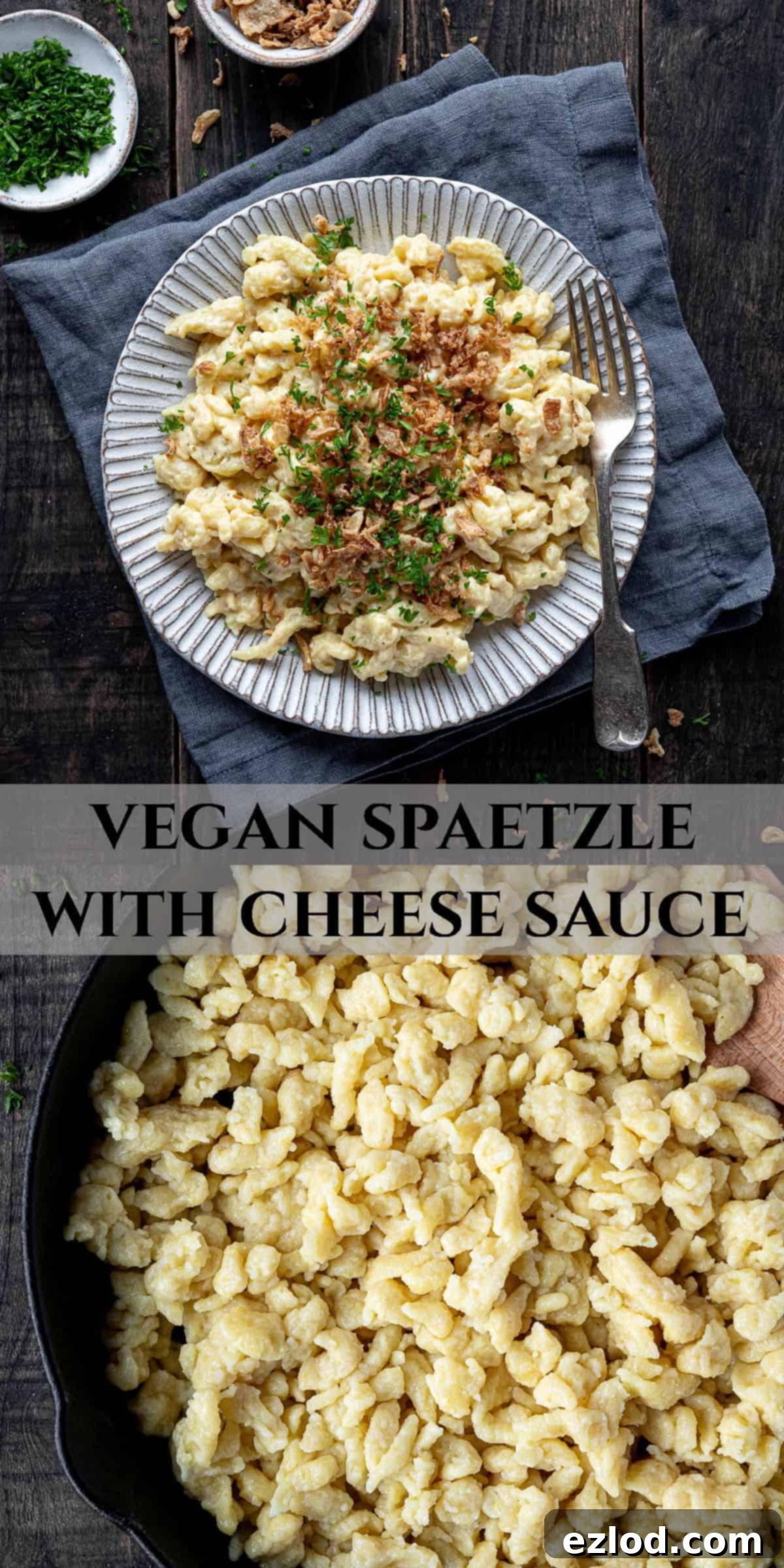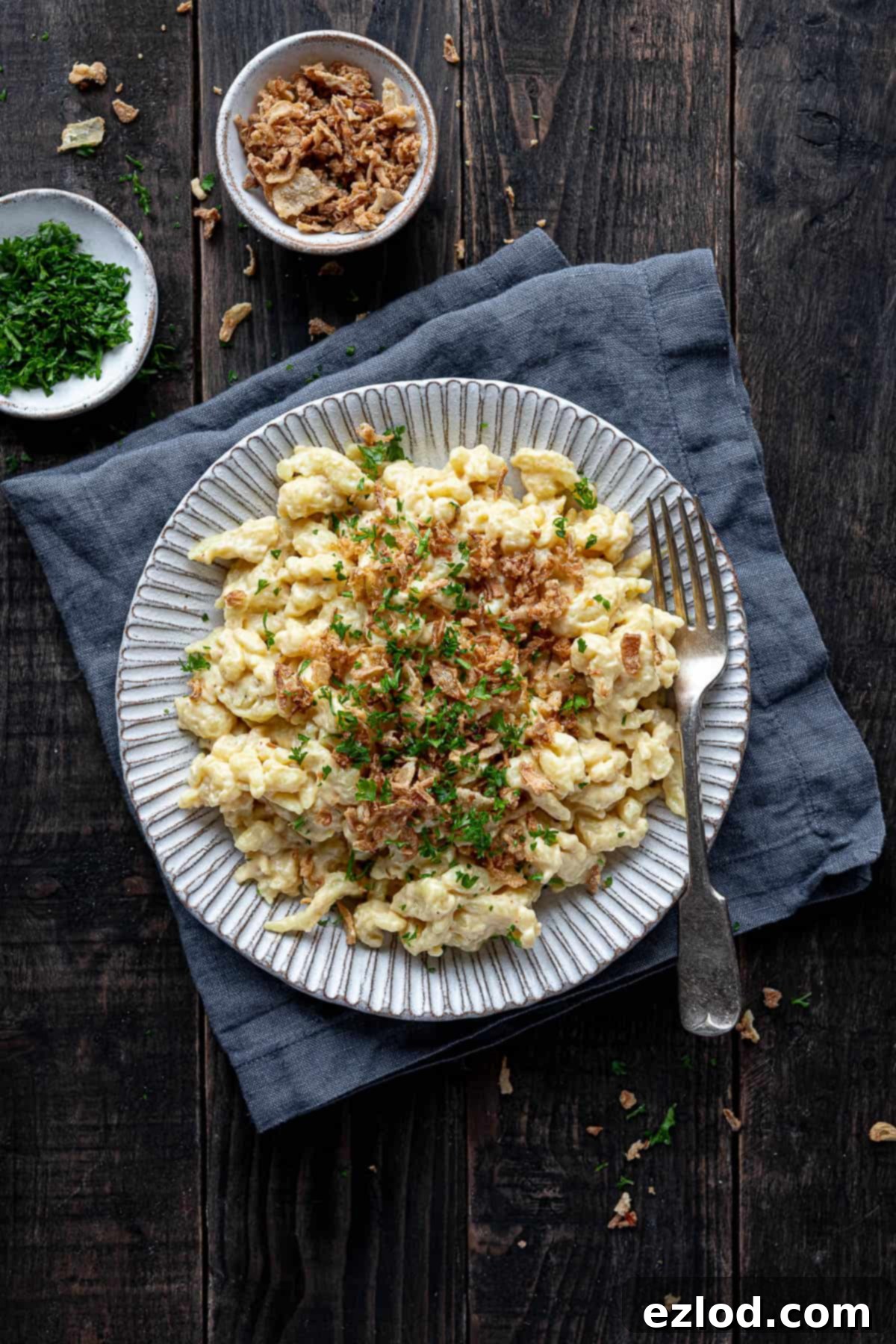Delicious Vegan Spaetzle: Easy Eggless German Noodle Dumplings for Ultimate Comfort
Discover the delightful world of vegan spaetzle – tender, chewy German noodle dumplings made entirely without eggs. This incredibly quick and easy recipe brings the beloved Central European comfort food to your plant-based kitchen in under 20 minutes! Perfectly paired with a rich, creamy vegan cheese sauce and crispy fried onions, it’s a hearty meal that feels like a warm hug in a bowl.
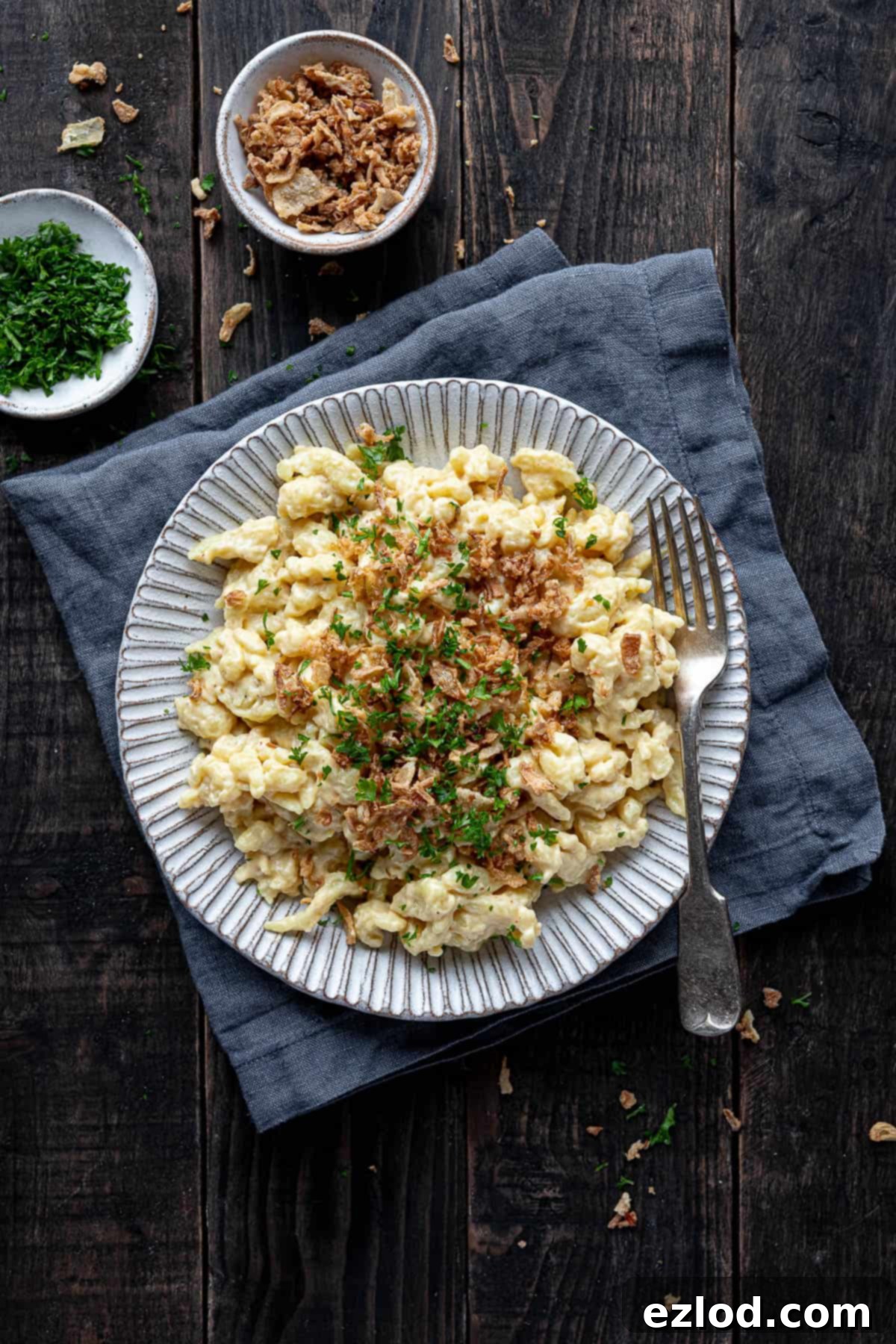
There’s something uniquely satisfying about a truly comforting meal, and these vegan spaetzle effortlessly claim a top spot on my list. The combination of soft, slightly chewy noodle dumplings, generously coated in a luxurious, dairy-free cheese sauce, and topped with golden, crispy fried onions, creates an unforgettable culinary experience. Best of all, this hearty and wholesome dish is surprisingly simple to whip up, making it perfect for weeknight dinners or a cozy weekend treat.
What Are Spaetzle and Why Go Vegan?
Spaetzle (often spelled spätzle) are a distinctive type of soft egg noodle or dumpling originating from Southern Germany. While they share similarities with pasta in texture and versatility, their unique irregular shape and method of preparation set them apart. Traditionally, spaetzle are a staple in German, Austrian, Swiss, Hungarian, and Alsatian cuisine, served as a side dish, in soups, or as the star of a main course like Kässpätzle (cheese spaetzle).
The traditional recipe heavily relies on eggs, which are crucial for the dough’s binding, structure, and distinct yellow hue. Veganizing such an egg-centric dish presents a delightful challenge! Early attempts by many, including myself, often involved egg substitutes like chickpea flour, which can sometimes result in an undesirably gluey texture. However, through culinary experimentation, a brilliant alternative emerged: a combination of semolina and starch. This magical duo successfully mimics the structural integrity and delightful bite that eggs typically provide, allowing us to create perfect eggless German dumplings.
Choosing to make vegan spaetzle isn’t just about dietary restrictions; it’s also about exploring delicious plant-based alternatives that are both ethical and often healthier. This recipe ensures that everyone can enjoy this classic German comfort food without compromising on taste or texture.
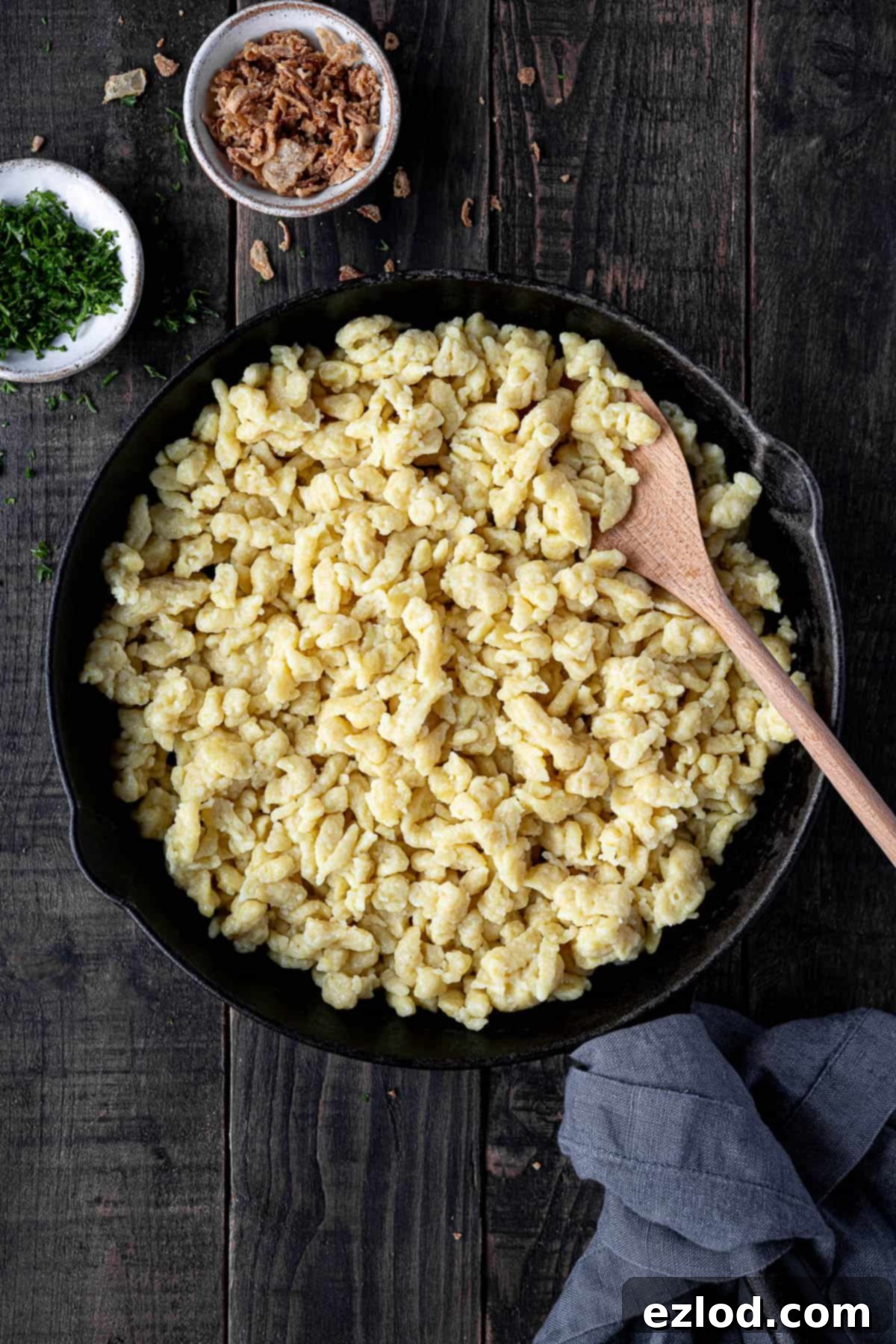
Essential Tools for Perfect Homemade Vegan Spaetzle
While mastering the art of scraping spaetzle dough off a wooden board into boiling water is a traditional technique, using a specialized spaetzle maker simplifies the process immensely and ensures more consistent results. There are several types of spaetzle makers available, each producing slightly different shapes of these delightful eggless German dumplings:
- Potato Ricer Style Spaetzle Press: This tool works much like a potato ricer. You fill the chamber with dough and press it through small holes directly into the boiling water, yielding longer, more noodle-like spaetzle. If you desire those classic elongated shapes, this is your go-to.
- Spaetzle Maker Pan Lid with Scraper: This type typically sits over your pot of boiling water. You pour the dough onto the perforated plate and use a scraper to push it through the holes. This method usually produces shorter, button-shaped spaetzle, also known as Knöpfle. This is the style I personally prefer for its charming shape and ease of use.
- Grater Shaped Board with Pusher: This design involves placing the dough on a small board with holes and then sliding a pusher back and forth to force the dough into the water below. It also tends to produce slightly longer, more irregular shapes than the pan lid style.
If you don’t have a dedicated spaetzle maker, you can get creative! A colander with large holes or even a coarse grater can work in a pinch. Just ensure the holes are large enough for the dough to pass through, and use a spatula or scraper to push it gently into the water. For an authentic experience, you could also try the traditional wooden board scraping method, but I highly recommend watching a few YouTube videos first to get the technique right!
Key Ingredients for Your Vegan Spaetzle Dough
Crafting the perfect eggless spaetzle dough requires a thoughtful selection of ingredients, each playing a vital role in achieving that desirable tender-chewy texture.
- Plain Flour (All-Purpose Flour): This is the base of our dumplings. Regular plain flour provides the necessary gluten structure for the spaetzle to hold their shape and develop that satisfying chew. I haven’t tested this recipe with other flours, so sticking to all-purpose is recommended for consistent results.
- Fine Semolina Flour: This ingredient is absolutely crucial for vegan spaetzle! Semolina, often used in pasta making, is made from durum wheat and provides the structure and characteristic “bite” that eggs would typically contribute. It prevents the dumplings from becoming too soft or mushy. It’s essential to use fine semolina; if you can only find coarse, a quick blitz in a high-powered blender will grind it finer. Do not skip or substitute semolina for the best results.
- Potato or Corn Starch: Either potato or corn starch works wonderfully, though I personally lean towards potato starch. These starches act as a binder and help to create a slightly softer, more tender crumb within the chewy dumpling, balancing the semolina’s firmness. If you don’t have starch, you can substitute with an equal amount of additional fine semolina, though the texture might be slightly firmer.
- Unsweetened Non-Dairy Milk: Any unsweetened plant-based milk will work, but I find soy milk provides the best consistency due to its protein content. It helps to bring the dough together and contributes to the overall moisture and tenderness.
- Olive Oil: A touch of olive oil replaces the richness and fat content typically found in egg yolks, adding a subtle depth of flavor and contributing to the spaetzle’s smooth texture.
- Baking Powder: Just a small amount of baking powder provides a slight lift, resulting in a lighter dumpling. While optional, it does make a noticeable difference in the final texture, preventing them from being too dense.
- Turmeric: This is entirely optional but highly recommended if you want to mimic the traditional golden-yellow color that eggs impart. A tiny pinch is all you need, and it won’t affect the flavor.
- Salt: Essential for seasoning the dough itself, bringing out the flavors of the other ingredients.
- Kala Namak (Black Salt): For those who enjoy a hint of “eggy” flavor, a tiny pinch of kala namak added to the dough can replicate that sulfuric note found in traditional egg dishes. This is an optional but fun addition for some palates.
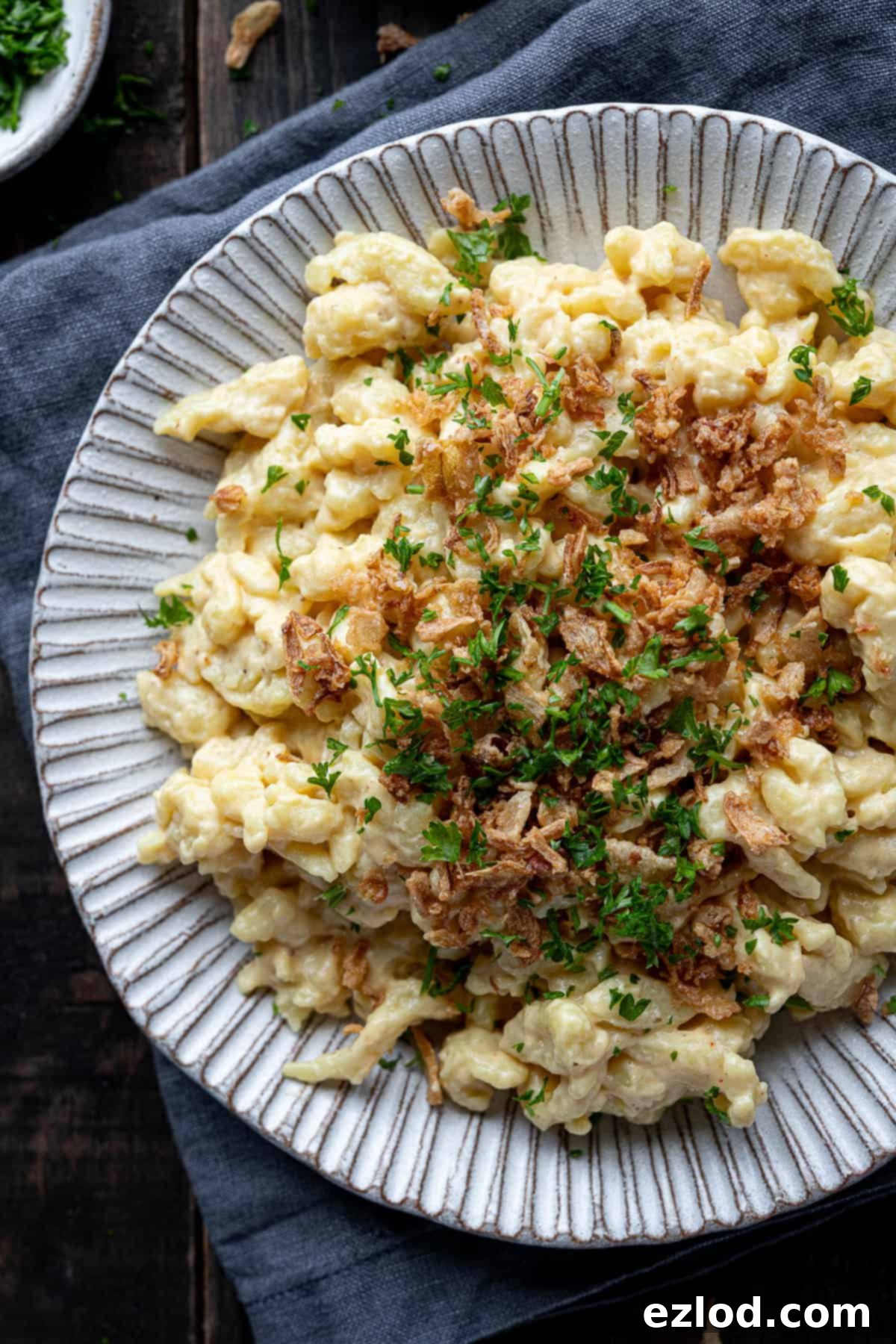
Crafting Your Vegan Spaetzle: A Step-by-Step Guide
(For precise measurements and full instructions, please refer to the comprehensive recipe card at the bottom of this page.)
Step 1: Prepare the Dry Ingredients
In a large mixing bowl, combine the plain flour, fine semolina flour, potato or corn starch, salt, baking powder, and optional turmeric. Whisk these dry ingredients together thoroughly to ensure they are evenly distributed. This step is crucial for consistent texture and flavor throughout your vegan spaetzle.
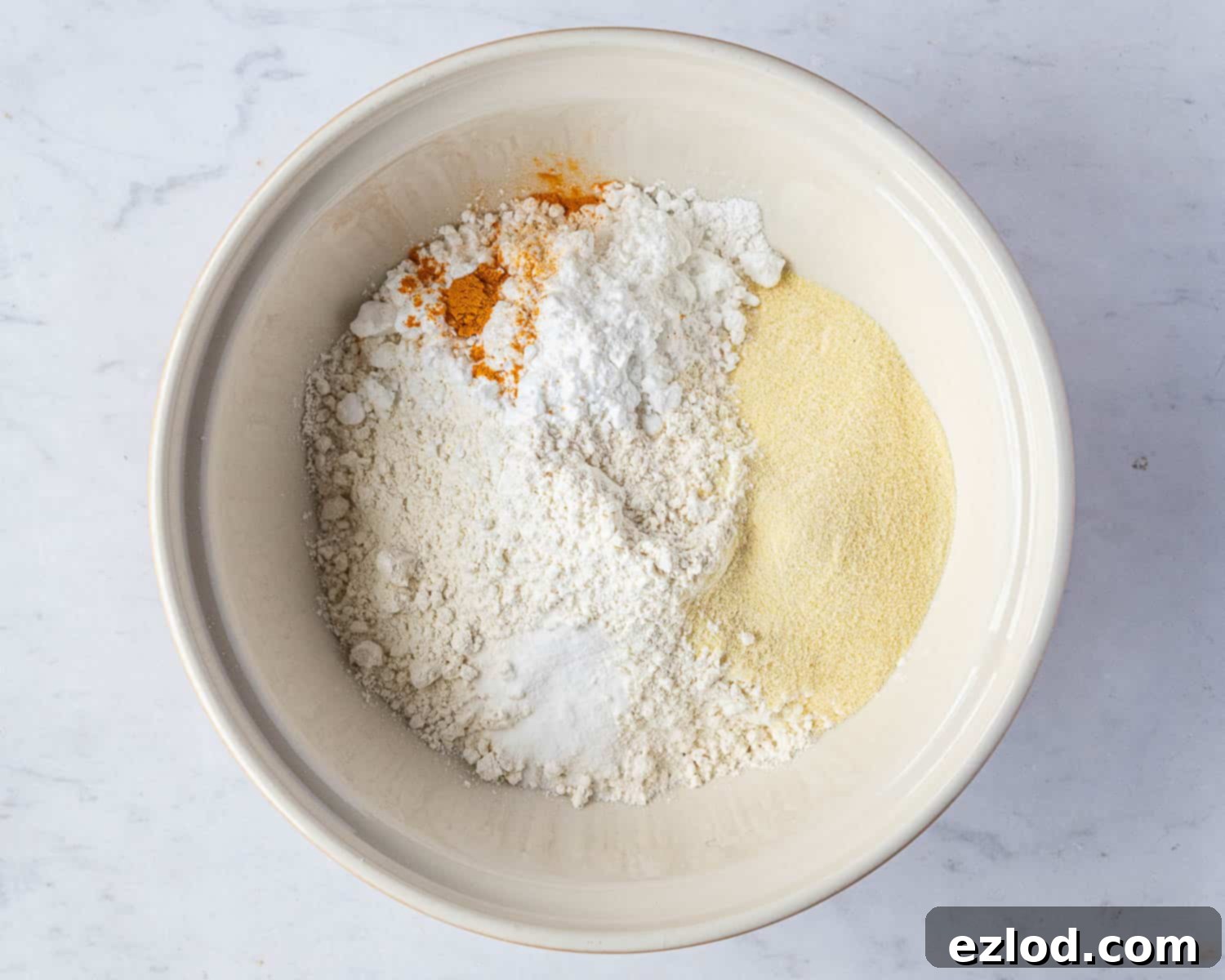
Step 2: Create the Wet Batter
Add the olive oil to the dry ingredients. Then, gradually pour in the unsweetened non-dairy milk, whisking continuously. Begin with 500ml (2 cups) of milk and only add the remaining 50ml (¼ cup) if the batter appears too thick. The goal is a consistency similar to a thick pancake batter – pourable but not watery. Once combined, beat the batter vigorously for a few minutes. This vigorous beating helps to activate the gluten in the flour, which is vital for the spaetzle’s chewy texture, and also incorporates air, which contributes to a slightly lighter dumpling. You should see small bubbles forming on the surface.
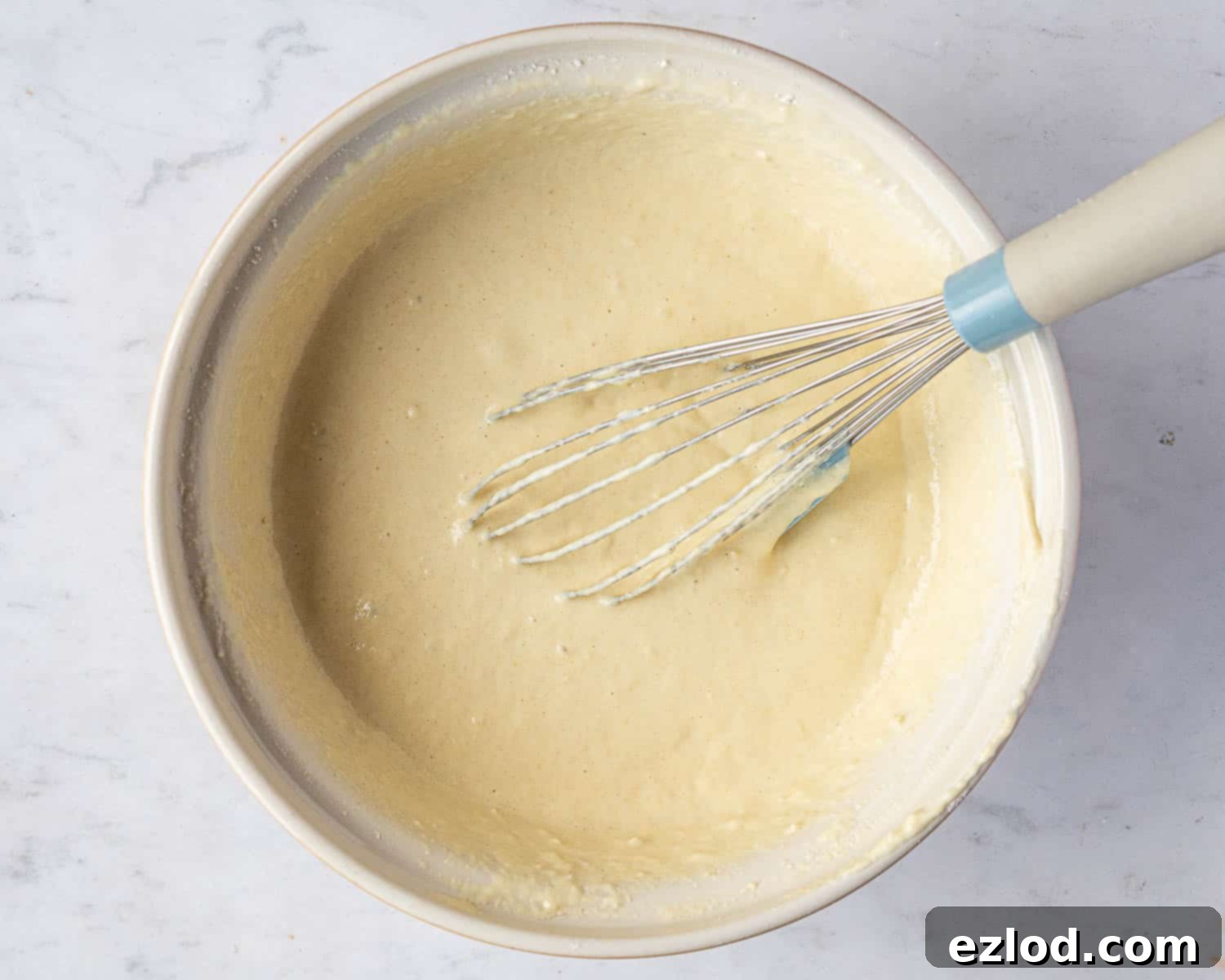
Step 3: Cook the Spaetzle
Bring a large pot of salted water to a rolling boil. Once boiling, reduce the heat slightly to maintain a gentle boil. Scoop a portion of the spaetzle batter into your chosen spaetzle maker (press, pan lid, or grater). If using a press, push the dough directly into the water. If using a pan lid or grater with a scraper, carefully scrape the batter through the holes into the simmering water below.
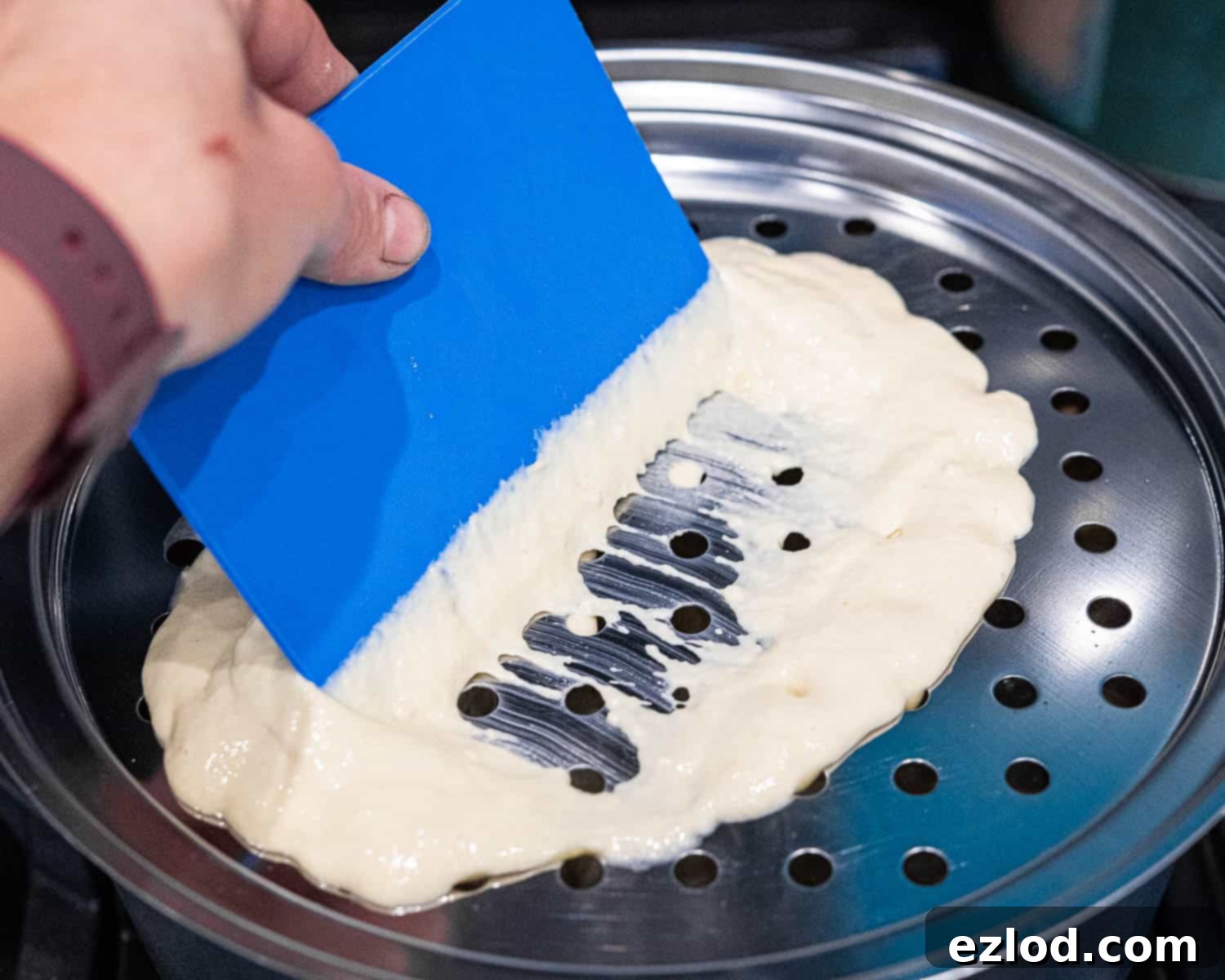
Step 4: Retrieve the Cooked Dumplings
The spaetzle cook very quickly. As soon as they float to the surface of the water, they are done. This usually takes only 1-2 minutes. Using a slotted spoon or a fine-mesh sieve, carefully skim the cooked spaetzle from the water and transfer them to a colander. Rinse them briefly with cold water to prevent them from sticking together. Repeat this process with the remaining batter, cooking in batches to avoid overcrowding the pot, which can lower the water temperature and lead to gummy spaetzle.
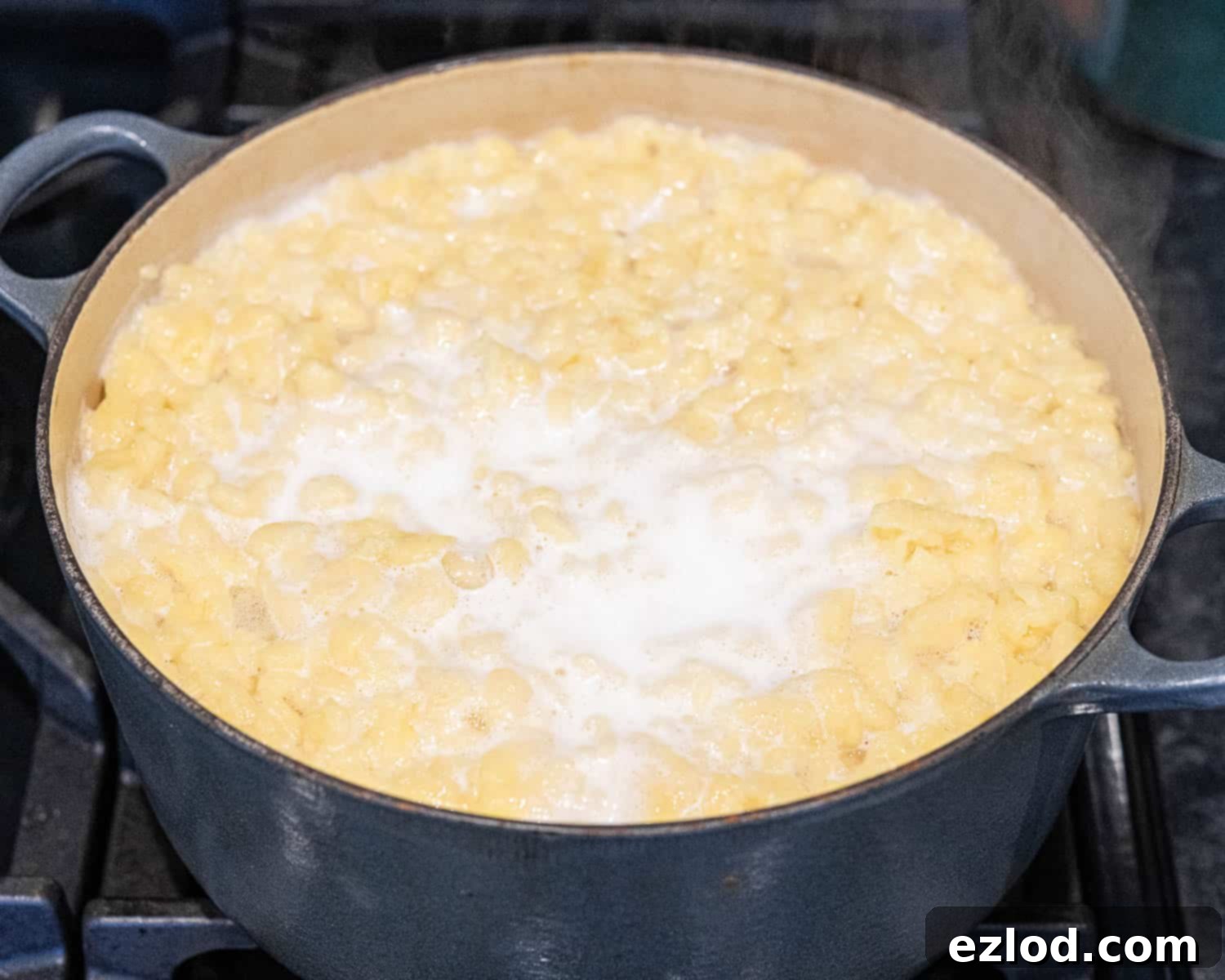
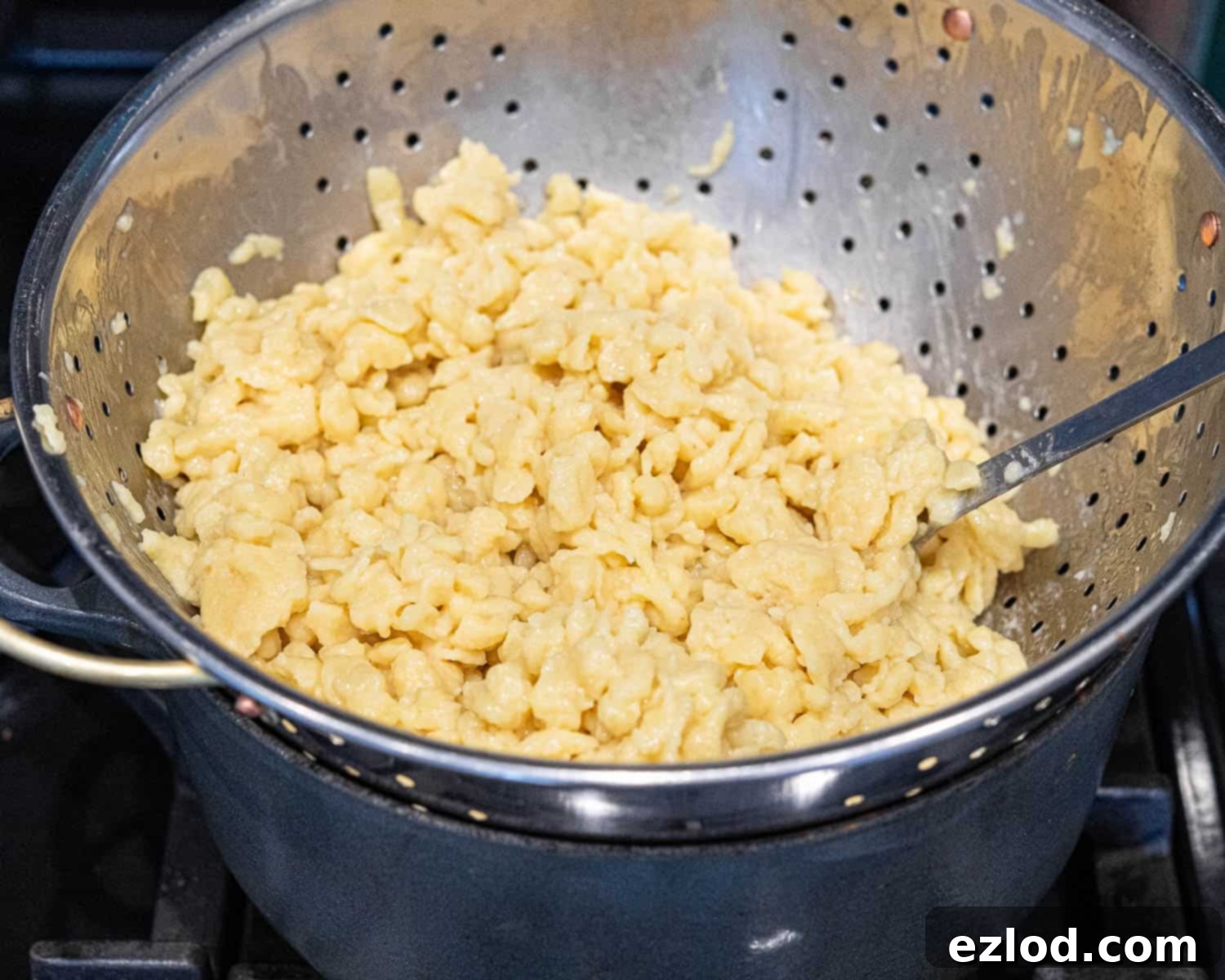
Step 5: Prepare the Creamy Vegan Cheese Sauce
While the spaetzle are being cooked, you can prepare the incredibly flavorful vegan cheese sauce. Begin by boiling the peeled and chopped potato, sliced carrot, and cashews until the vegetables are completely soft and easily pierced with a fork. This ensures a perfectly smooth sauce.
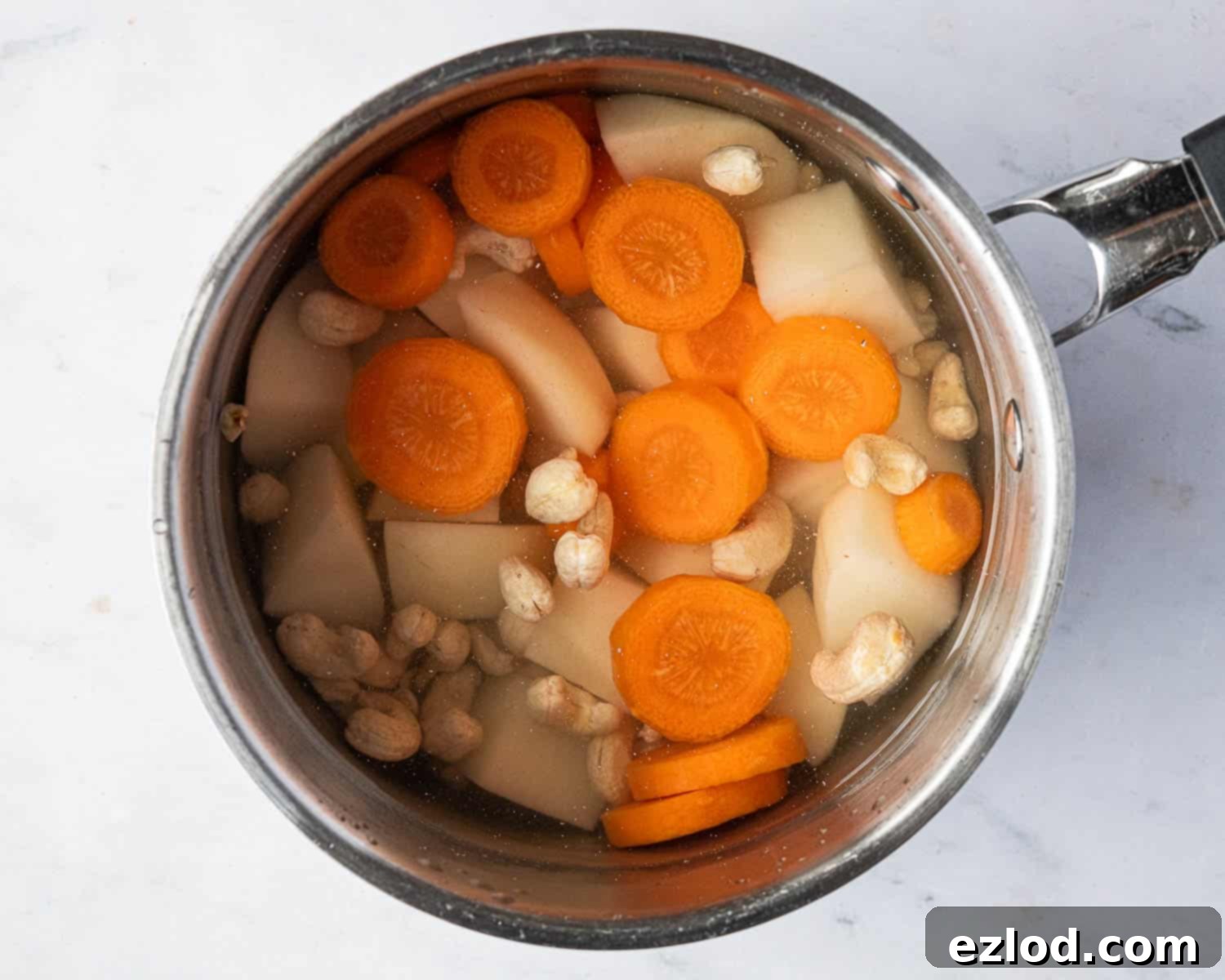
Step 6: Blend to Perfection
Once the vegetables are soft, drain them well. Transfer the drained potato, carrot, and cashews to a high-speed blender. Add the remaining cheese sauce ingredients: a stock cube, nutritional yeast (for that essential cheesy flavor), salt, wholegrain mustard (for a subtle tang), lemon juice, garlic powder, onion powder, smoked paprika (for depth and a hint of smokiness), olive oil, and unsweetened non-dairy milk. Blend until the sauce is incredibly smooth and creamy, with no discernible lumps. Taste and adjust seasonings as needed.
Pro Tips for Vegan Spaetzle Success
To ensure your vegan spaetzle turn out perfectly every time, keep these expert tips in mind:
- Measure with Precision: As with most baking and dough-based recipes, accuracy is key. I strongly recommend using metric measurements with a digital kitchen scale rather than imprecise cup conversions. This will yield far more consistent and reliable results. Plus, it’s often cleaner and easier!
- Avoid Overcrowding: Cook the spaetzle in small batches, about 3-4, depending on the size of your pot. Overcrowding the water will drastically lower its temperature, leading to undercooked or gummy spaetzle that clump together.
- Rinse Immediately: As soon as the spaetzle are cooked, rinse them briefly with cold water. This stops the cooking process and, more importantly, prevents them from sticking to each other, ensuring each dumpling remains separate and perfectly textured.
- Taste the Water: Just like pasta, the cooking water for spaetzle should be well-salted. This seasons the dumplings from the inside out.
- Adjust Batter Consistency: If your batter seems too thick to easily pass through your spaetzle maker, add a tiny bit more non-dairy milk, one tablespoon at a time, until you reach the desired consistency. If it’s too thin, you can whisk in a tablespoon of extra flour.
- Sauté for Extra Flavor: While traditionally served directly from the pot, a common German practice (especially for Kässpätzle) is to briefly sauté the cooked spaetzle in a pan with a little vegan butter until lightly golden. This adds an extra layer of flavor and a slightly crispier exterior.
Can I Prepare Vegan Spaetzle in Advance?
Absolutely! Vegan spaetzle are excellent for meal prep. Once cooked, rinsed, and drained, the spaetzle can be stored in an airtight container in the refrigerator for up to 5 days. When you’re ready to eat, reheat them gently in a non-stick pan with a little olive oil or vegan butter, or simply microwave until warmed through. Sautéing them usually gives the best texture.
Can I Freeze Vegan Spaetzle?
Yes, vegan spaetzle freeze beautifully! After cooking, rinse the spaetzle with cold water and drain them extremely well. Spread them out in a single layer on a baking tray and freeze until solid. Once frozen, transfer the spaetzle to a freezer-safe bag or container, where they will keep for up to 3 months.
To reheat from frozen, there’s no need to defrost. Simply add the frozen spaetzle directly to a pot of boiling water and cook until they are heated through and float to the surface again. Drain them well and serve as desired.
Creative Ways to Serve Vegan Spaetzle
While the combination of creamy vegan cheese sauce and crispy fried onions is undeniably a match made in heaven for these eggless German dumplings, vegan spaetzle are incredibly versatile and can be enjoyed in many delicious ways:
- Classic Kässpätzle Style: Our recommended serving method! Toss the warm spaetzle with the homemade vegan cheese sauce and top generously with store-bought crispy fried onions and a sprinkle of fresh parsley for a comforting, hearty meal.
- Simple Side Dish: Serve plain spaetzle tossed with melted vegan butter and a pinch of salt and pepper as a delightful side to hearty stews, vegan goulash, roasted vegetables, or plant-based schnitzel.
- As a Pasta Alternative: Use vegan spaetzle anywhere you would typically use short pasta. They work wonderfully in baked casseroles, with your favorite vegan pesto, or even in a creamy mushroom sauce.
- With Gravy or Sauce: They are perfect for soaking up rich gravies from dishes like a vegan roast or mushroom stroganoff.
- Sweet Variations: While less common for savory spaetzle, some traditional German versions are served sweet with applesauce or fruit compote – a creative experiment for the adventurous palate!
More Irresistible Vegan Comfort Food Recipes:
If you loved these vegan spaetzle, you’ll definitely want to try some of my other favorite plant-based comfort food recipes:
- Vegan Chilli Cornbread Pie
- Vegan Swedish Meatballs
- Chickpea, Leek and Mushroom Pie
- Vegan Pasta Bake
- Vegan Cottage Pie
- Creamy Vegetable Rice Soup
- Vegan Mushroom Stroganoff
- Vegan Chicken Potato Pie
- Vegan Lentil Walnut Bolognese
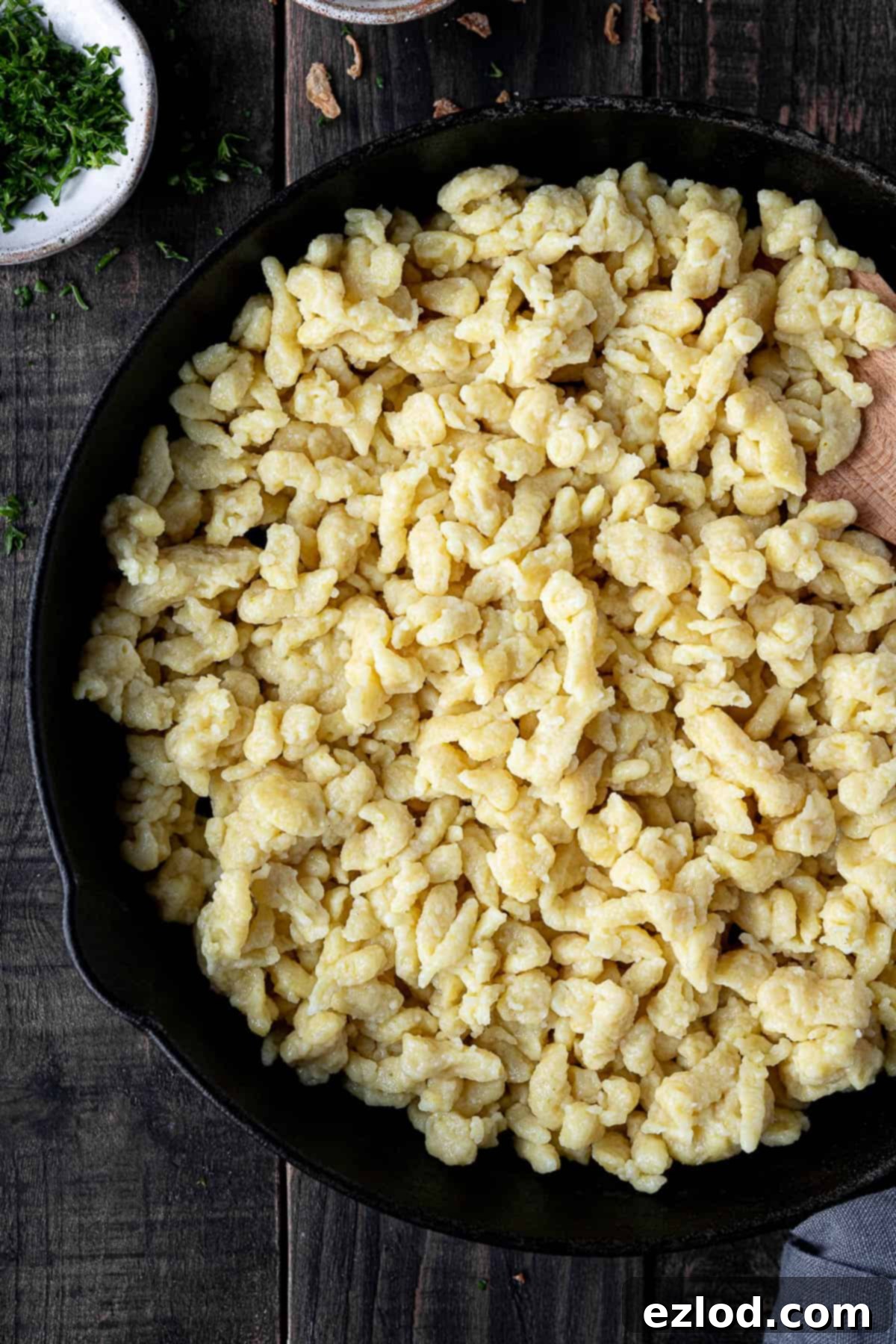
If you tried this incredible Vegan Spaetzle recipe, I’d love to hear from you! Please rate it, leave a comment below, or tag @domestic_gothess on Instagram and use the hashtag #domesticgothess. Your feedback is truly appreciated!
All images and content on Domestic Gothess are copyright protected. If you wish to share this recipe, please do so by using the provided share buttons. Do not screenshot or post the recipe or its content in full; instead, kindly include a link back to this original post for the complete recipe.

Vegan Spaetzle
Ingredients
Spaetzle:
- 375 g (3 cups) plain (all-purpose) flour
- 70 g (5 ½ Tablespoons) fine semolina flour
- 40 g (4 packed Tablespoons) potato or corn starch (or use more semolina)
- 1 teaspoon salt
- ¼ teaspoon baking powder
- ⅛ teaspoon turmeric (optional)
- 2 Tablespoons oil
- 500-550 ml (2 – 2 ¼ cups) unsweetened non-dairy milk (I use soy)
Cheese Sauce:
- 250 g potato (1 large) peeled and cut into chunks
- 1 medium carrot sliced
- 70 g (½ cup) cashews
- 1 stock cube
- 4 Tablespoons nutritional yeast
- ½ teaspoon salt
- 1 teaspoon wholegrain mustard
- 1 Tablespoon lemon juice
- 1 teaspoon garlic powder
- 1 teaspoon onion powder
- ¼ teaspoon smoked paprika
- 1 Tablespoon olive oil
- 250 ml (1 cup) unsweetened non-dairy milk (I use soy)
Instructions
-
Mix together the flour, semolina, potato or corn starch, salt, baking powder and turmeric in a large bowl.
-
Add the oil and gradually whisk in the milk. Start with 500ml and add the extra 50ml only if needed. The batter should be like a thick pancake batter consistency. Beat it well until bubbles start to form.
-
Heat a large pan of water until boiling. Scoop some of the batter into a spaetzle press and press the spaetzle into the boiling water. If you have one like mine, scoop some of the batter onto the plate and use a scraper to scrape it into the water.
-
Once the spaetzle float to the top they are cooked. Skim them off using a slotted spoon and place in a colander. Rinse briefly with cold water and drain well. Repeat with the rest of the batter.
-
To make the cheese sauce, boil the potato, carrot and cashews until the vegetables are soft.
-
Drain well and place in a blender along with the stock cube, nutritional yeast, salt, mustard, lemon juice, garlic and onion powders, smoked paprika, olive oil and milk and blend until smooth.
Notes
- See post above for tips, details and step-by-step photos.
- As with all of my recipes I really do recommend using the metric measurements with a digital scale rather than the cup conversions. Cups are a wildly inaccurate measuring system and you will get far better, more consistent results using a scale, not to mention that it is also easier and less messy than cups!
